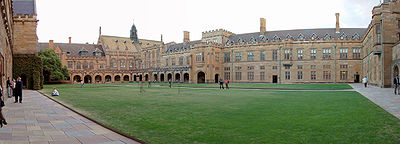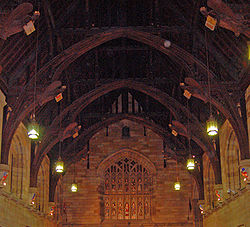
Great Hall of the University of Sydney
Encyclopedia
The Great Hall of the University of Sydney
, Australia
, is one of the principal structures of the University, with a public interior used for formal ceremonies, conferences, recitals and dinners. The Hall, located in the Main Quadrangle on the Camperdown campus, is an iconic symbol of the University's stately history and an excellent example of Victorian Gothic revival architectural .
 Designed by Sir Edmund Thomas Blacket (1817–1883), the Great Hall lies at the most northeastern point of the university Quadrangle - dominating the sweeping lawns of University Place, as well as University Avenue, which overlooks Victoria Park. Blacket, who was appointed Colonial Architect of New South Wales from 1849–1854, resigned from his position in 1855 to pursue the design of new buildings for the University - supervising both their development, and construction, until their completion in 1862. Blacket's other notable achievements include the design of St. Paul's College
Designed by Sir Edmund Thomas Blacket (1817–1883), the Great Hall lies at the most northeastern point of the university Quadrangle - dominating the sweeping lawns of University Place, as well as University Avenue, which overlooks Victoria Park. Blacket, who was appointed Colonial Architect of New South Wales from 1849–1854, resigned from his position in 1855 to pursue the design of new buildings for the University - supervising both their development, and construction, until their completion in 1862. Blacket's other notable achievements include the design of St. Paul's College
and the alteration of the original construction of St. Andrew's Cathedral
in Sydney, from architect James Hume's original design.
The Great Hall was completed in 1859, and represents one of Blacket's finest accomplishments. On July 18, 1859, degrees were first conferred upon graduates by the University in a formal ceremony in the Hall. During 1881–1882, a Forster & Andrews pipe organ was installed, later to be replaced in 1971-72 by the present organ which was manufactured by German builder Rudolf von Beckerath of Hamburg.
, in a design that reflects, and harmoniously complements, its counterpart, the University Quadrangle.
 Westminster Hall, the oldest existing interior of the Palace of Westminster
Westminster Hall, the oldest existing interior of the Palace of Westminster
in London
, served as Blacket's model for the Great Hall's design. Westminster Hall, erected during the reign of William II
in 1097, was later altered during the reign of Richard II
between 1394 and 1399. The King commissioned architects Henry Yevele
and Hugh Herland
to replace the original roof, supported by two pillars, with a more sophisticated hammerbeam roof
. Westminster Hall then survived a fire on October 16 1834, which destroyed much of the remaining palace.
, Hampton Court and Etham Castle, all equally typical of Gothic constructions. The marble floor, elevated upon the western side of the hall, mirrors the dais found in Westminster Hall, upon which the throne of King Richard II stood.
The armorial bearings upon the southern side of the Hall, as well as the frame of the Oriel window, have been carved of Caen stone. The walls are otherwise constructed of New South Wales
sandstone, with a floor of marble. The great beams of the roof are of cedar wood.
University of Sydney
The University of Sydney is a public university located in Sydney, New South Wales. The main campus spreads across the suburbs of Camperdown and Darlington on the southwestern outskirts of the Sydney CBD. Founded in 1850, it is the oldest university in Australia and Oceania...
, Australia
Australia
Australia , officially the Commonwealth of Australia, is a country in the Southern Hemisphere comprising the mainland of the Australian continent, the island of Tasmania, and numerous smaller islands in the Indian and Pacific Oceans. It is the world's sixth-largest country by total area...
, is one of the principal structures of the University, with a public interior used for formal ceremonies, conferences, recitals and dinners. The Hall, located in the Main Quadrangle on the Camperdown campus, is an iconic symbol of the University's stately history and an excellent example of Victorian Gothic revival architectural .
History

St. Paul's College, Sydney
St Paul's College in Sydney, Australia, is an Anglican residential college for men which is affiliated with the University of Sydney. Founded in 1856 by an 1854 act of the New South Wales Legislative Council, it is Australia's oldest university college...
and the alteration of the original construction of St. Andrew's Cathedral
St. Andrew's Cathedral, Sydney
St Andrew's Cathedral is the cathedral church of the Anglican Diocese of Sydney in the Anglican Church of Australia. The cathedral is the seat of the Anglican Archbishop of Sydney and Metropolitan of New South Wales, the Most Reverend Peter Jensen...
in Sydney, from architect James Hume's original design.
The Great Hall was completed in 1859, and represents one of Blacket's finest accomplishments. On July 18, 1859, degrees were first conferred upon graduates by the University in a formal ceremony in the Hall. During 1881–1882, a Forster & Andrews pipe organ was installed, later to be replaced in 1971-72 by the present organ which was manufactured by German builder Rudolf von Beckerath of Hamburg.
Architecture
The Great Hall is recognised as one of the finest examples of the Victorian Gothic revival style of architecture in AustraliaAustralia
Australia , officially the Commonwealth of Australia, is a country in the Southern Hemisphere comprising the mainland of the Australian continent, the island of Tasmania, and numerous smaller islands in the Indian and Pacific Oceans. It is the world's sixth-largest country by total area...
, in a design that reflects, and harmoniously complements, its counterpart, the University Quadrangle.
Westminster model

Palace of Westminster
The Palace of Westminster, also known as the Houses of Parliament or Westminster Palace, is the meeting place of the two houses of the Parliament of the United Kingdom—the House of Lords and the House of Commons...
in London
London
London is the capital city of :England and the :United Kingdom, the largest metropolitan area in the United Kingdom, and the largest urban zone in the European Union by most measures. Located on the River Thames, London has been a major settlement for two millennia, its history going back to its...
, served as Blacket's model for the Great Hall's design. Westminster Hall, erected during the reign of William II
William II of England
William II , the third son of William I of England, was King of England from 1087 until 1100, with powers over Normandy, and influence in Scotland. He was less successful in extending control into Wales...
in 1097, was later altered during the reign of Richard II
Richard II of England
Richard II was King of England, a member of the House of Plantagenet and the last of its main-line kings. He ruled from 1377 until he was deposed in 1399. Richard was a son of Edward, the Black Prince, and was born during the reign of his grandfather, Edward III...
between 1394 and 1399. The King commissioned architects Henry Yevele
Henry Yevele
Henry Yevele was the most prolific and successful master mason active in late medieval England. The first document relating to him is dated 3 December 1353, when he purchased the freedom of London...
and Hugh Herland
Hugh Herland
Hugh Herland was a 14th century medieval English carpenter. He was the chief carpenter to King Richard II.One of his best known pieces is the hammer-beam roof at Westminster Hall, regarded as one of the greatest carpentry achievements of the time...
to replace the original roof, supported by two pillars, with a more sophisticated hammerbeam roof
Hammerbeam roof
Hammerbeam roof, in architecture, is the name given to an open timber roof, typical of English Gothic architecture, using short beams projecting from the wall.- Design :...
. Westminster Hall then survived a fire on October 16 1834, which destroyed much of the remaining palace.
The University Design
Like its English counterpart, a wooden, hammerbeam roof is adorned by ten carved angels. The arched design of the roof is supported by six collar beams, and is architecturally reminiscent of such British interiors as those of Stirling CastleStirling Castle
Stirling Castle, located in Stirling, is one of the largest and most important castles, both historically and architecturally, in Scotland. The castle sits atop Castle Hill, an intrusive crag, which forms part of the Stirling Sill geological formation. It is surrounded on three sides by steep...
, Hampton Court and Etham Castle, all equally typical of Gothic constructions. The marble floor, elevated upon the western side of the hall, mirrors the dais found in Westminster Hall, upon which the throne of King Richard II stood.
The armorial bearings upon the southern side of the Hall, as well as the frame of the Oriel window, have been carved of Caen stone. The walls are otherwise constructed of New South Wales
New South Wales
New South Wales is a state of :Australia, located in the east of the country. It is bordered by Queensland, Victoria and South Australia to the north, south and west respectively. To the east, the state is bordered by the Tasman Sea, which forms part of the Pacific Ocean. New South Wales...
sandstone, with a floor of marble. The great beams of the roof are of cedar wood.

